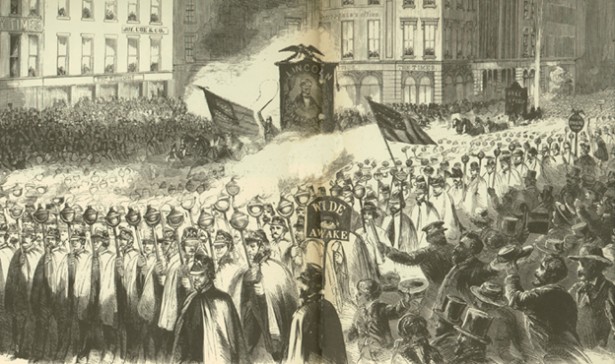
American elections have often been defined by who is not allowed to vote.
Two days before the Declaration of Independence, for example the New Jersey Constitution declared that all residents “who are worth fifty pounds” could vote. (That included women and African Americans, but by 1807 that line was rewritten so that only white men were eligible.)
During the 19th century voters – again, only white adult males – were often organized into paramilitary units. The Wide Awakes, affiliated with the Republicans, would march off to vote in a torch light parade.
After the civil war that franchise was extended, slowly, state by state, to all males.
But in April 1880 John Elk presented himself to a county official in Omaha, Nebraska, and attempted to register to vote. The clerk “designedly, corruptly, willfully, and maliciously, did then and there refuse to register this plaintiff, for the sole reason that the plaintiff was an Indian, and therefore not a citizen of the United States, and not therefore entitled to vote.”
On the next day Elk went to the polls anyway. The same clerk was a judge and again refused to give Elk a ballot.
Eventually the Supreme Court agreed. It basically said that Elk had been born an Indian, therefore was not a citizen, and could not vote. He owed his “immediate allegiance to” his tribe, not the United States, the court said.
Congress supposedly fixed that in 1924 when it passed the Citizenship Act. But that was a Washington, D.C. idea – and states continued to deny American Indians and Alaska Natives the right to vote. South Dakota, Idaho, Maine, Mississippi, New Mexico, Utah and Arizona all found legal loopholes to prevent Native Americans from voting until as late as 1962. The civil rights movement, and stricter federal oversight during the 1960s and 1970s, increased access for Native American voters. (The National Congress of American Indians’ Native Vote project has the goal of this election turning out the largest Native vote in history.)
All of this history builds into the storyline for the 2012 election. This cycle there has been a determined and steady call to restrict voting participation across the country. The battle to register people to vote is more complicated, partly because it now includes early voting and other methods to engage more people in the process.
Early voting has become a routine for many voters, nearly one third of the ballots cast in 2008, and as much as half this time around. It’s convenient and especially easy for rural people, such as those on reservations, because it reduces transportation issues. Tribes in Montana filed a voting rights suit last week to press for early voting opportunities in that state.
But while early voting, and indeed, access to voting should be non-partisan, it’s not. Republicans have led the charge to limit access to the polls using a variety of methods from requiring identification to ending early voting.
In Ohio, for example, the Republican Secretary of State was blunt. He said early voting was an advantage for Democrats. He wrote: “After talking with election officials across the state, I have decided to level the playing field on voting days and hours during the absentee period in order to ensure that the Presidential Election in Ohio will be uniform, accessible for all, fair, and secure.”
A level playing field that restricts voting? But early voting is popular in Ohio (and where ever it’s open). People like being able to pop by a poll whenever it’s convenient for them. One study found that early voters “tend to have lower income than election-day voters” with the difference “most noticeable among people with annual incomes of less than $35,000.” In other words: People who have a tough time leaving work, or school, and voting on a set schedule.
Last week, the U.S. Court of Appeals affirmed a lower court ruling that struck down Ohio’s limits to early voting. The Secretary of State has asked the Supreme Court to review the case. And quickly.
Think Progress, a liberal website, said there is urgency because of polls that show early voters are far more inclined to pick Obama. One recent poll showed that 60 percent of Obama voters had already cast ballots, compared to 39 percent for Romney.
In Pennsylvania there is a similar fight over a strict voter ID law, but a court also struck down that law as well as one in South Carolina. More than 30 states have some requirements to show identification at the polls, and many, such as Idaho, now incorporate tribal IDs into that requirement.
A voting rights group in Minnesota is trying to educate Native American voters about ID laws. “I use my voice and my vote to stand up for future generations,” says one of the voices on the video spot. That state has a measure on the ballot to require ID in future elections.
An election that will once again define who can’t vote.
Mark Trahant is a writer, speaker and Twitter poet. He is a member of the Shoshone-Bannock Tribes and lives in Fort Hall, Idaho. He has been writing about Indian Country for more than three decades. His e-mail is: marktrahant@thecedarsgroup.org.